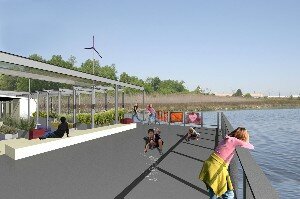ONARCHITECTURE- Float their boat: 'Learning Barge' teaches lessons
They've designed solar houses, affordable green modular housing, projects to help rebuild the Gulf Coast, and are redesigning Campbell Hall, but the UVA School of Architecture's most recent design-build project may be its most unusual.
Recently, Assistant Professor of Architecture Phoebe Crisman and her students scored a $100,000 grant from the Virginia Environmental Endowment to build and launch an experimental barge on the Elizabeth River, which, according to Crisman, is the most polluted river feeding the Chesapeake Bay.
Called the "Learning Barge," the 120-foot-long, 30-foot-wide river boat will be a veritable model of sustainability, handling its own waste, recycling rain water, and powering its lights and heat with solar and wind energy. The barge would function as a floating classroom to teach school children and the general public about the river's ecosystem, Portsmouth's role as an international port, and the ongoing effort to clean it up.
It will also serve as a self-sustaining lab for UVA grad students to conduct research. With room for over 60 people, the barge would feature a floating oyster nursery on its side and an on-board artificial wetland to demonstrate how plants and soil naturally filter and clean river water.
In addition, much of the barge will be designed and built by UVA students with recycled materials. If all goes according to plan– and if additional funding is secured– the detailed designs will be complete in the fall, construction will begin at a Norfolk shipyard in January, and the barge will be launched next August, says Crisman.
The undertaking grew out of Crisman's work with the Elizabeth River Project, a grassroots environmental organization based in Portsmouth that has been trying to clean up the river. Crisman, who specializes in green revitalization, was working on an environmental clean-up project along the river and wanted to help the organization in its outreach efforts.
"With its shipyards and naval yards, it's the economic engine of the whole region," says Crisman. "But the river has borne the brunt of that." Although many areas of the river are flourishing again thanks to clean-up efforts, Crisman wanted to see more people involved in the process.
"It's hard to even get near the water in that area," she says, "because it's so industrialized. So we came up with the barge idea. This is an excellent way to educate people, to have a physical presence on the river."
The final barge design was a collaborative effort between Crisman, her students, the Institute for Environmental Negotiation, and faculties of the Department of Environmental Sciences, the Curry School of Education, and the School of Engineering and Applied Science.
In an elaborate, semester-long studio design process, what began as 11 separate designs for the barge were eventually distilled into one design that represented the best aspects of all the designs. Apparently, it was an exhilarating experience for Crisman and her students, who were more than happy to get their hands dirty.
"This is something we've been doing a lot of at the architecture school," says Crisman, talking about the school's growing number of design-build projects. "It's great to make something happen instead of just talking about it."
Crisman is particularly interested in the barge's ability to educate kids, and is working directly with the Portsmouth school system to develop a curriculum.
"There are kids who live right along the river," says Crisman of the economically depressed region, "and they never get out on it. This is something that kids can really understand. This will not be your typical boat ride. Rather than a ship, it's a floating platform where things happen."
On a grander scale, Crisman hopes the barge will be a place where both kids and adults will be able to see the impact we as humans have on the environment. In the past, says Crisman, it was industry's careless use of the river that led to its pollution, but today the most serious threat comes from urban run-off. In fact, the Elizabeth River still has many heavily polluted, lifeless areas.
"I hope the barge will be a place where people will really understand the connectivity of their actions to natural forces," she says.

River ride: Its designers hope UVA's new "Learning Barge" will be a model of sustainability and a way to connect people to the environment.
Rendering courtesy of Crisman Studio, UVA School of Architecture
#
2 comments
Read about the Learning Barge in article in Lowe's Creative Ideas magazine (Jan/Feb 2008) and want to learn more about "first voyage in August 2008." Is this open to the public? How might I find out more details?
I like to know more, thank´s.